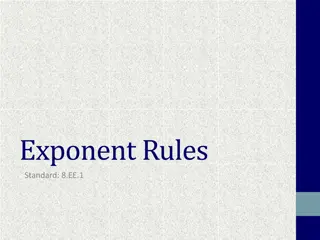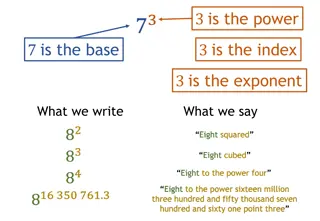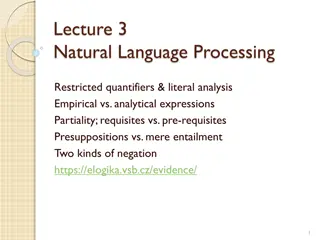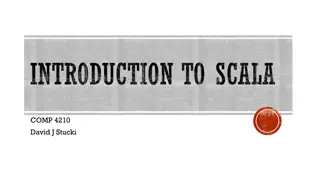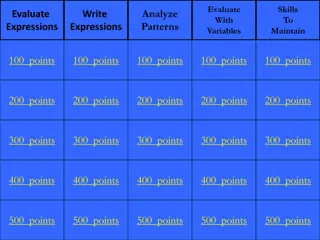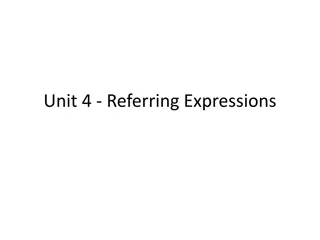Exploring Advanced For Expressions in Scala
Delve into the world of for expressions in Scala by revisiting key concepts, including the N-Queens Problem and querying techniques. Learn how to translate for expressions and generalize the notation, building on the foundational knowledge from Chapter 16 on map, flatMap, and filter functions.
Download Presentation

Please find below an Image/Link to download the presentation.
The content on the website is provided AS IS for your information and personal use only. It may not be sold, licensed, or shared on other websites without obtaining consent from the author. Download presentation by click this link. If you encounter any issues during the download, it is possible that the publisher has removed the file from their server.
E N D
Presentation Transcript
Chapter 23 For Expressions Revisited 1
Overview - For Expressions - N-Queens Problem - Querying With For Expressions - Translating For Expressions - Generalizing The For Notation 2
Introduction - Chapter 16 talks about map, flatMap, and filter - These functions can make a program difficult to understand 3
Suppose we have the following: case class Person(name: String, isMale: Boolean, children: Person*) 4
What if we wanted to find the names of all pairs of mothers and their children in the list? val cece = Person( Cece , false) val philip = Person( Philip , true) val pam = Person( Pam , false, cece, philip) val persons = List(pam, philip, cece)
Using map, flatMap, and withFilter: persons withFilter (p => !p.isMale) flatMap (p => (p.children map (c => (p.name, c.name)))) result: List[(String, String)] = List((Pam,Cece), (Pam,Philip)) Bit hard to understand, isn t it?
Use a for expression! for (p <- persons; if !p.isMale; c <- p.children) yield (p.name, c.name) result: List[(String, String)] = List((Pam,Cece), (Pam,Philip))
A for expression has the following form: for (seq) yield expr Example: for (p <- persons; n = p.name; if (n == Wanda )) yield n 9
for { } yield n p <- persons n = p.name if (n == Wanda ) // generator // definition // filter
A generator has the following form: pat <- expr - Every for expression starts with a generator - expr will typically return a list - pat will get matched against all elements of the list 11
A definition has the following form: pat = expr - Binds pat to the value of expr - Most of the time pat will be a variable x
A filter has the following form: If expr - expr is of type Boolean 13
- Solution would consist of a list of coordinates (row, column) - It has to be built up gradually - Let s use a recursive algorithm 15
- Assume you have already generated all solutions of placing k queens on a board of size N x N, where k is less than N - To place the next queen in row k + 1, generate all possible extensions of each previous solutions by one more queen 16
def queens(n: Int): List[List[(Int, Int)]] = { def placeQueens(k: Int): List[List[(Int, Int)]] = if (k == 0) List(List()) else for { queens <- placeQueens(k - 1) column <- 1 to n queen = (k, column) if isSafe(queen, queens) } yield queen :: queens placeQueens(n) }
- queens only calls placeQueens - placeQueens generates all partial solutions - placeQueens returns a list of lists 18
queens <- placeQueens(k - 1) - Iterates through all solutions 19
column <- 1 to n - Iterates through all possible columns
queen = (k, column) - Defines a new queen to be a coordinate
if isSafe(queen, queens) - Checks whether the new queen is under attack
- for notation = common operations of database languages - Suppose we have the class definition: case class Movie(title: String, directors: String*)
val movies: List[Movie] = List( Movie( Avengers: Infinity War , Joe Russo , Anthony Russo ), Movie( Star Wars: The Empire Strikes Back , Irvin Kershner ), Movie( Midsommar , Ari Aster ), Movie( Cloverfield , Matt Reeves ) )
- To find the title of all movies whose director s name is Joe: for (m <- movies; a <- m.directors if a startsWith Joe") yield m.title result: List[String] = List(Avengers: Infinity War)
- To find the title of all movies that have the string War in their title: for (m <- movies if (m.title indexOf War") >= 0) yield m.title result: List[String] = List(Avengers: Infinity War, Star Wars: The Empire Strikes Back)
- Every for expression can be expressed in terms of: map flatMap withFilter - Used by the Scala compiler
for expressions with one generator for(x <- expr1) yield expr2 = expr1.map(x => expr2)
for expressions starting with generator and filter for(x <- expr1 if expr2) yield expr3 for(x <- expr1 withFilter(x => expr2) yield expr3 expr1 withFilter(x => expr2) map (x => expr3) 31
for expressions starting with 2 generators for(x <- expr1; y <- empr2; seq) yield expr3 = expr1.flatMap(x => for(y <- expr2; seq) yield expr3 32
Tuples in generators for((x1, . . . , xn)<- expr1) yield expr2 = expr1.map { case(x1, . . . , xn) => expr2 }
Arbitrary patterns in generators for(pat <- expr1) yield expr2 = expr1 withFilter { case pat => true case _ => false } map { case pat => expr2 } 35
Translating definitions for(x<- expr1; y = expr2; seq) yield expr3 = for((x, y)<- for( x <- expr1) yield (x,expr2); seq) yield expr3 36
Translating for loops - Translates in a similar way to for expressions - Just replace map and flatMap with foreach for(x<- expr1) body = expr1 foreach (x => body)
Going the other way - You can go from map, flatMap, and filter to for expressions 38
object Demo { def map[A, B](xs: List[A], f: A => B): List[B] = for (x < xs) yield f(x) // produce a call to map def flatMap[A, B](xs: List[A], f: A => List[B]): List[B] = for (x <-xs; y <- f(x)) yield y // produce a call to flatMap def filter[A](xs: List[A], p: A => Boolean): List[A] = for (x <- xs if p(x)) yield x // produce a call to withFilter }
- It is possible for your own data types to support for expressions - You need to define map, flatMap, withFilter, and foreach as methods of your data type 41
- Suppose you have a class C representing some sort of collection - It s typical to pick the following: abstract class C[A] { def map[B](f: A => B): C[B] def flatMap[B](f: A => C[B]): C[B] def withFilter(p: A => Boolean): C[A] def foreach(b: A => Unit): Unit }
Monad - You can formulate functions map, flatMap, and withFilter on a monad - You can characterize every monad by map, flatMap, and withFilter, plus a "unit" constructor 43




